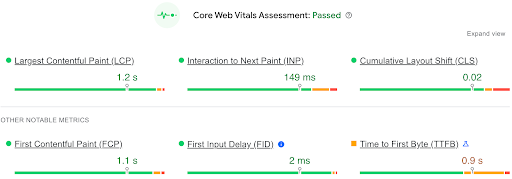As new technologies emerge, algorithms change and people change the way they consume information online, eCommerce businesses need to be aware of these trends to stay ahead of the changes in the search engine results pages (SERPs). From the power of video content to writing quality content for users, let’s take a look at the top SEO trends for 2024.
We’ve seen an increase in the amount of video content consumed online due to the increasing popularity of short-form video content on various social media platforms, changes in user behaviour and search engines favouring video content in the SERPs. By optimising your video content for SEO, you’re content is likely to perform better organically, but it’s important that you do it right.
Just Kampers are a great example of how video content can be used and optimised to promote their eCommerce products in a way that is natural and relevant for users. Their short and to-the-point videos, accompanied by text that reflects what is covered in the video are an excellent way to optimise video content for users and search engines.
If you use video as part of your SEO strategy, here are some best practices to improve your video performance:
Ensure that video titles and descriptions are informative and contain the target keyword.
Correctly use schema markup to inform search engines about what your content is about. If you’d like us to audit your video content, get in touch with our specialists.
Encourage viewers to engage with your videos.
Create high-quality, informative videos that match the interests of your audience.
Video transcripts should be available to make your videos searchable and accessible.
Depending on the type of content that you’re publishing, the information can quickly become outdated as user interests change and new competitors emerge. Regular content audits help identify which pieces of content may need revising to ensure that it’s as relevant as possible.
Here are some best practices to ensure that your content is as up-to-date as possible:
Analyse Analytics: Analyse analytics to identify which posts have decreased in traffic over time.
Consider Relevance: Ensure that your content is relevant and reflects industry trends and updates. You might need to add new sections based on major changes within your industry.
Update Internal Links: Review and update internal links within your content if necessary.
Optimise For New Keywords: Consider optimising for new keywords that have emerged since the original post date, as long as they align naturally with the content.
Include ‘Last Updated On’: Particularly on non-eCommerce pages, clearly indicating when the page was last updated signifies that your content is fresh and relevant.
Promote Updated Content: Refreshing your content is only effective if your audience knows about it. Use your email newsletters and social media channels to inform your followers about the updated content.
Monitor Performance Changes: After refreshing content, closely monitor changes in its performance metrics. This includes organic traffic, ranking positions, engagement rates and conversion metrics to understand what works well for your audience and what might need further adjustment.
At Proof3, we constantly strive to improve our client pages, from blog pages to improving priority category pages. Here are some key examples of how refreshing category pages helped one of our client’s pages improve year on year.
Category
Autumn Planting – Crocuses
Autumn Planting – Alliums
Autumn Planting – Hyacinths
Clicks Difference
+76%
+117%
+138%
Impressions Difference
+98%
+148%
+125%
Positions Difference
+8 positions
+21 positions
+12 positions
Take a look at our how to update SEO content blog if you’d like to learn more about how we can help you to update your content.
Artificial intelligence (AI) has become a fundamental feature for enhancing user experience and making processes more efficient for businesses, from providing user-centric features like chatbots to aiding in research and analysis. As AI continues to learn, it will continue to offer endless opportunities for online businesses.
Here are some of the many ways that AI can be used to improve your business:
Research & Analysis: AI can be used to read and summarise large pieces of information. This will help if you want to research and summarise information efficiently.
Personalised User Experience (UX): Predictive analytics forecasting future trends and user behaviour allows us to tailor marketing strategies more effectively.
Streamlined Automation: Elements like metadata can be automatically created with the help of natural language processing.
Chatbots: AI-driven chatbots provide instant responses to queries, making websites more interactive and accessible. Below we’ve added an example of how Wood2U,, a wood-effect flooring specialist, clearly displays chatbots on their website to give users prompt responses.

With more and more people using AI, ensuring that your site displays expertise, experience, authoritativeness and trustworthiness (E-E-A-T) has never been more important. By following E-E-A-T guidelines, Google will favour your content as it displays unique value that AI-written content doesn’t provide.
Here are some tips and best practices to ensure that your website reflects E-E-A-T practices:
Show unique expertise by producing well-researched, informative content that is backed up by authoritative sources.
Use your own data for case studies to display expertise in your industry and is based on first-hand experience.
Including author information such as qualifications and industry experience reinforces the trust and credibility of your site. Here’s a nice example from Sole Supplier on their Author Bio’s.

Take a look at our E-E-A-T blog to learn more about E-E-A-T guidelines and how to optimise for them.
As previously mentioned, the way that people search online has drastically changed, and search engines are reflecting this in the way that they present information using search generative experience (SGE).
As it stands, SGE is an experimental search experience that uses AI to provide users with quick and clear overviews of search generative experience (SGE).

With search engines changing the way that they present results to users in the SERPs, it’s important that your website adapts to these changes to ensure that your content is displayed prominently.
To get the most out of SGE and user search behaviour, consider these best practices to drive more effective and successful SEO outcomes:
Optimise Content For Voice Search: Include question-based queries in a way that people would speak to create a conversational tone that aligns with how users would use SGE.
Optimise For Mobile: Offer a seamless, mobile-friendly experience to retain visitors and improve search rankings. Take a look at Google’s official documentation to learn more about the importance of mobile-first indexing.
Incorporate Featured Snippets: Structure content to directly answer common questions to improve your chances of securing relevant featured snippets.
Personalise Content: Personalise content to meet the needs and preferences of your target audience.
Ensuring that your site is responsive and easy to navigate is imperative for the success of any online business. In fact, 53% of visits are abandoned if a site takes longer than 3 seconds to load on mobile, so potential customers could be leaving your site before they’ve even looked at what you’re offering. Let’s take a look at the importance of optimising your site speed, mobile responsiveness and streamlined navigation to enhance UX:
Mobile Responsiveness: Mobile devices account for over 50% of web traffic worldwide, so it’s a no-brainer to ensure that your site is optimised for mobile devices. Mobile responsiveness ensures that content is easily accessible and readable across various devices. This not only enhances UX, but also aligns with search engines’ mobile-first indexing policies.
Streamlined Navigation: A user-friendly navigation enables users to find information quickly and efficiently. Streamlining your site’s navigation enhances UX, reduces bounce rates and encourages users to explore your site.
Site Speed: Your website loading time can significantly influence user satisfaction and search engine rankings. In fact, a delay of a few seconds can increase bounce rates. By using tools like Page Speed Insights, we can evaluate how your web pages are performing for core web vitals, as shown below.

Narrow topical relevance simply means focusing on a specific topic of expertise. For example, if you specialise in pet supplies, you shouldn’t post content about personal health-care routines as it is not relevant to your topic of expertise. Following a narrow topical relevance strategy comes with several advantages:
Expertise & Authority: Focussing on a specific topic indicates that you have a deeper level of expertise and authority. This can enhance your site’s credibility, which aligns with E-E-A-T guidelines.
Targeted Audience Engagement: Narrow topical relevance allows you to create content that directly meets the needs and interests of your audience, resulting in higher engagement rates.
Community Building: Content that resonates with a specific audience helps create a community of readers who share a common interest. This community can become a loyal audience who are more likely to return to the site and share the content.
Although covering broader topics can attract a wider audience, narrow topical relevance helps you become an expert leader in your field, which is crucial for creating a strong online presence.
To excel in local SEO, you should be present across various platforms to improve online visibility and attract more customers from your local community. Below, we have added some best practices that will increase your presence in local search results:
Google My Business:Helps you manage your online presence across Google Search and Maps. Ensure that your business profile is accurate and includes your business name, address, phone number and opening hours.
Leverage Customer Reviews: Encourage your customers to leave reviews. Important: Respond to both positive and negative reviews to show that you value your customers.
Build Backlinks: High-quality, authoritative external links to your website can significantly boost your visibility in local search results. Prioritise building relationships with local businesses, newspapers and relevant community websites to increase the likelihood of them naturally linking to your site. This not only builds authority from external links to your site, but it also helps to build brand awareness.
User signals are patterns of user behaviour which search engines use to determine your website’s rankings in the SERPs. With the shift in how search algorithms are using AI and natural language processing to determine whether content meets the search intent, optimising for user signals and search intent has never been more important.
By understanding user signals and aligning your content strategy with search intent, you can successfully create a more satisfying UX that exceeds the changing expectations of users and search engines. To help your content show in the SERPs, follow these best practices:
Understand Search Intent: Create content based on keyword intent (informational, navigational, commercial and transactional). For example, if your main keyword is informational, how-to guides are a fantastic option.
Analyse Engagement Metrics: Use tools like Google Analytics to monitor user engagement metrics like bounce rate, time on page and CTR.
Revise Content Based on User Behaviour: Consider optimising elements like search intent, structure, visuals and call-to-action (CTA) used on lower-performing content. If you’d like more advice on how to get the most engagement on aspects of your content like CTA placements based on data-driven insights, get in touch with our CRO team.
Perform A/B Testing: Test variations of your content, titles, meta descriptions and CTAs to see which variations perform best.
Segment User Data for More Insights: Segment your data by device type, geographical location and channels to allow you to tailor your content more effectively to these segments.
